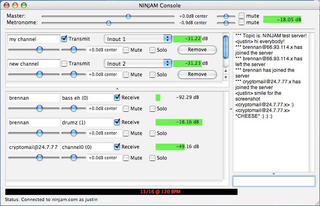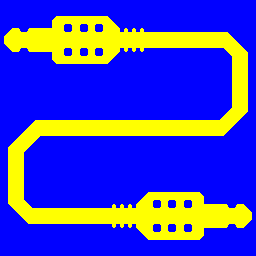Related Research Articles
In computer networks, download means to receive data from a remote system, typically a server such as a web server, an FTP server, an email server, or other similar systems. This contrasts with uploading, where data is sent to a remote server. A download is a file offered for downloading or that has been downloaded, or the process of receiving such a file.
Steinberg Media Technologies GmbH is a German musical software and hardware company based in Hamburg. It develops music writing, recording, arranging, and editing software, most notably Cubase, Nuendo, and Dorico. It also designs audio and MIDI hardware interfaces, controllers, and iOS/Android music apps including Cubasis. Steinberg created several industry standard music technologies including the Virtual Studio Technology (VST) format for plug-ins and the ASIO protocol. Steinberg has been a wholly owned subsidiary of Yamaha since 2005.

Pro Tools is a digital audio workstation (DAW) developed and released by Avid Technology for Microsoft Windows and macOS. It is used for music creation and production, sound for picture and, more generally, sound recording, editing, and mastering processes.

GarageBand is a line of digital audio workstations developed by Apple for macOS, iPadOS, and iOS devices that allows users to create music or podcasts. GarageBand was originally released for macOS in 2004 and brought to iOS in 2011. The app's music and podcast creation system enables users to create multiple tracks with pre-made MIDI keyboards, pre-made loops, an array of various instrumental effects, and voice recordings.

A digital audio workstation (DAW) is an electronic device or application software used for recording, editing and producing audio files. DAWs come in a wide variety of configurations from a single software program on a laptop, to an integrated stand-alone unit, all the way to a highly complex configuration of numerous components controlled by a central computer. Regardless of configuration, modern DAWs have a central interface that allows the user to alter and mix multiple recordings and tracks into a final produced piece.
Logic Pro is a proprietary digital audio workstation (DAW) and MIDI sequencer software application for the macOS platform developed by Apple Inc. It was originally created in the early 1990s as Notator Logic, or Logic, by German software developer C-Lab which later went by Emagic. Apple acquired Emagic in 2002 and renamed Logic to Logic Pro. It is the second most popular DAW – after Ableton Live – according to a survey conducted in 2015.

NINJAM stands for Novel Intervallic Network Jamming Architecture for Music. The software and systems comprising NINJAM provide a non-realtime mechanism for exchanging audio data across the internet, with a synchronisation mechanism based on musical form. It provides a way for musicians to "jam" (improvise) together over the Internet; it pioneered the concept of "virtual-time" jamming. It was originally developed by Brennan Underwood, Justin Frankel, and Tom Pepper.

Apple TV is a digital media player and microconsole developed and marketed by Apple Inc. It is a small network appliance hardware that sends received media data such as video and audio to a television set or external display. Its media services include streaming media, TV Everywhere-based services, local media sources, and sports journalism and broadcasts.

Soundbooth is a discontinued digital audio editor by Adobe Systems Incorporated for Windows XP, Windows Vista, 7 and Mac OS X. Adobe has described it as being "in the spirit of SoundEdit 16 and Cool Edit 2000". Adobe also has a more powerful program called Adobe Audition, which replaced Soundbooth as of Adobe Creative Suite 5.5 Production Premium. Soundbooth, discontinued in 2011, was aimed at creative professionals who do not specialize in audio or people who need a simple editing program and do not require the full features of Adobe Audition. Due to Intel-specific code, Adobe stated that the Mac OS X version would only be available for machines using Intel processors. Soundbooth CS4 was the first version to support 64-bit officially.
Spotify is a Swedish audio streaming and media services provider founded on 23 April 2006 by Daniel Ek and Martin Lorentzon. It is one of the largest music streaming service providers, with over 551 million monthly active users, including 220 million paying subscribers, as of June 2023. Spotify is listed on the New York Stock Exchange in the form of American depositary receipts.

Virtual Audio Cable is a software product based on WDM multimedia driver that allows a user to transfer audio streams from one application to another. Any application is able to send an audio stream to the input side of a "virtual cable" while a corresponding application can receive this stream from the output side. Since all transfers are made digitally, there is no loss in sound quality. VAC is the audio equivalent of a MIDI loopback device such as MultiMid or Hubi, and can be used instead of "Stereo Mix" or "What U Hear" features of audio adapters.
A music streaming service is a type of streaming media service that focuses primarily on music, and sometimes other forms of digital audio content such as podcasts. These services are usually subscription-based services allowing users to stream digital copyright restricted songs on-demand from a centralized library provided by the service. Some services may offer free tiers with limitations, such as advertising and limits on use. They typically incorporate a recommendation engine to help users discover other songs they may enjoy based on their listening history and other factors, as well as the ability to create and share public playlists with other users.
A networked music performance or network musical performance is a real-time interaction over a computer network that enables musicians in different locations to perform as if they were in the same room. These interactions can include performances, rehearsals, improvisation or jamming sessions, and situations for learning such as master classes. Participants may be connected by "high fidelity multichannel audio and video links" as well as MIDI data connections and specialized collaborative software tools. While not intended to be a replacement for traditional live stage performance, networked music performance supports musical interaction when co-presence is not possible and allows for novel forms of music expression. Remote audience members and possibly a conductor may also participate.

Opus is a lossy audio coding format developed by the Xiph.Org Foundation and standardized by the Internet Engineering Task Force, designed to efficiently code speech and general audio in a single format, while remaining low-latency enough for real-time interactive communication and low-complexity enough for low-end embedded processors. Opus replaces both Vorbis and Speex for new applications, and several blind listening tests have ranked it higher-quality than any other standard audio format at any given bitrate until transparency is reached, including MP3, AAC, and HE-AAC.
Nimble Streamer is a software media server developed by Softvelum. The server is used for streaming of live and on-demand video and audio to desktop computers, mobile devices, internet-connected TV sets, IPTV set-top boxes and other network-connected devices. Its first stable version 1.0.0-1 was released on October, 21st, 2013, with a number of preliminary versions done before that. The release cycle is intensive and introduces a new version every week or less. Nimble Streamer was the finalist in Streaming Media European Readers' Choice Awards for 2016 as the Best Streaming Innovation and for 2021 as Hardware/software Server.

Jamulus is open source (GPL) networked music performance software that enables live rehearsing, jamming and performing with musicians located anywhere on the internet. Jamulus is written by Volker Fischer and contributors using C++. The Software is based on the Qt framework and uses the OPUS audio codec. It was known as "llcon" until 2013.
When playing music remotely, musicians must reduce or eliminate the issue of audio latency in order to play in time together. While standard web conferencing software is designed to facilitate remote audio and video communication, it has too much latency for live musical performance. Connection-oriented Internet protocols subject audio signals to delays and other interference which presents a problem for keeping latency low enough for musicians to play together remotely.
LoLa is proprietary networked music performance software, first conceived in 2005, that enables real-time rehearsing and performing with musicians at remote locations, overcoming latency - the time lapse that occurs while (compressed) audio streams travel to and from each musician.
References
- ↑ Prince, Andy (12 March 2014). "JamKazam Lets Musicians Play Together from Different Locations". www.businesswire.com. Retrieved 5 January 2021.
JamKazam, the developer of a new live music platform and social network for musicians, today announced the public beta release
- ↑ Wistrom, Brent (15 July 2016). "Diversity in Tech: How Peter Walker Built 2 Austin Companies with Limited Funding". www.bizjournals.com. Austin Inno. Retrieved 5 January 2021.
JamKazam [...] has found ways to reduce latency enough to allow musicians to jam together online from afar
- ↑ Rosen, Peter (2020-11-15). "Social Distancing For Musicians: A Quick Guide To Low-Latency Audio" . Retrieved 2020-12-26.
- ↑ "What Are JamKazam's Free vs. Premium Features?". JamKazam. 2020-12-05. Retrieved 2020-12-25.
- ↑ Castillo, Maria (17 September 2020). "JamKazam: How low-latency conferencing software is revolutionizing music education". The Muhlenberg Weekly. Retrieved 5 January 2021.
- ↑ Young, Doug (15 May 2020). "Virtual Jamming: The Latest Tools for Playing Together in Real Time". Acoustic Guitar. Retrieved 5 January 2021.
JamKazam has just added the ability to stream a session, including audio and video to Facebook or YouTube, allowing musicians from remote locations to perform a virtual concert.
- ↑ "JamKazam Launches JamTracks to Re-Imagine Backing Tracks for Musicians". PRWeb. Retrieved 5 January 2021.
- ↑ "Jamulus - Internet Jam Session Software / Discussion / Open Discussion: Effects of the Corona virus on Jamulus". sourceforge.net. Retrieved 2020-11-08.
- ↑ "Band Practice at Home Alone, Together: How JamKazam Became an Essential App Amid Self-Isolation". Billboard. Retrieved 5 January 2021.